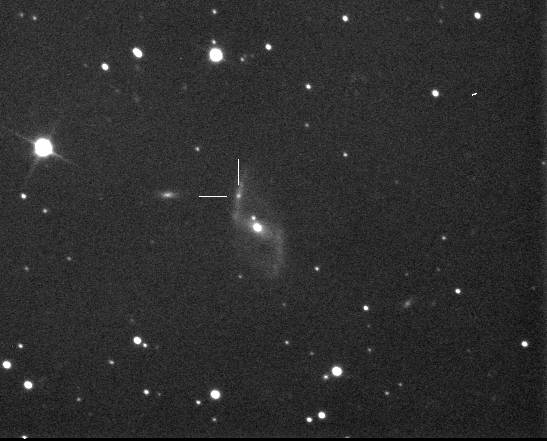SN2015aj (PSN J06280368+7418338) located near UGC 3460, discovered by Paolo Campaner on behalf of Italian Supernovae Search Project (ISSP).
Data from Latest Supernovae (http://www.rochesterastronomy.org/supernova.html)
, CBAT TOCP discovered 2015/09/02.100 by Paolo Campaner (ISSP)
Found in UGC 3460 at R.A. = 06h28m03s.68, Decl. = +74°18'33".8
Located 18".0 east and 28".0 north of the center of UGC 3460 (Discovery image) (M. Caimmi image) (Paolo Campaner image) (William Wiethoff image)
Mag 18.1:9/4, Type IIP (z=0.017652) (References: ATEL 8008)
Discover image:

And Classification Atel:
Asiago spectroscopic classification of one SN candidates
ATel #8008;
Questo indirizzo e-mail è protetto dallo spam bot. Abilita Javascript per vederlo.
on 7 Sep 2015; 08:38 UT
Distributed as an Instant Email Notice Supernovae
Credential Certification: N. Elias-Rosa (
Questo indirizzo e-mail è protetto dallo spam bot. Abilita Javascript per vederlo.
)
Subjects: Optical, Supernovae
The Asiago Transient Classification Program (Tomasella et al. 2014, AN, 335, 841) reports the spectroscopic classification of PSN J06280368+7418338 in the galaxy UGC 3460, discovered by P. Campaner (ISSP). Information on these transients are also available from the "Bright Supernova" website (http://www.rochesterastronomy.org/snimages/) and the CBAT Transient Object Followup Reports (http://www.cbat.eps.harvard.edu/index.html). The observations were performed with the Asiago 1.82 m Copernico Telescope (+AFOSC; range 340-820 nm; resolution 1.4 nm).
Name | Discovery | z | Type | Observation date | Phase | Notes PSN J06280368+7418338 | 2015-09-02.100 | 0.017652 | IIP | 2015-09-06.091 | ~5-6 weeks | (1)
(1) The spectrum shows P-Cygni Lines of H, Fe II and Na I typically observed in Type II SNe during the H recombination phase. From the minimum of Halpha, we infer an ejecta velocity of about 6200 km/s (slightly lower, about 5100 km/s, from the minimum of Hbeta). The redshift is from RC3, via NED.
The classification was done with SNID (Blondin and Tonry 2007, ApJ, 666, 1024). The Asiago classification spectra are posted at the website http://sngroup.oapd.inaf.it.




